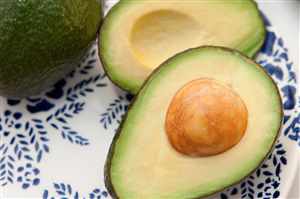Avocado (Persea americana)
Main Facts about Avocado

Avocado is a tree native to Mexico and Central America. Its fruit – strictly speaking, it is a large berry with a single seed inside – is also called Avocado or Alligator Pear. There are over 50 varieties of Avocados with different shape (from pear-shaped to round) and color (from green to black). All of them belong to the genus/species group called Persea Americana. They can weigh from 8 oz (220 g) to 3 lbs. (1.4 kg).
Avocado is a rather unique type of fruit. Most fruit consists primarily of carbohydrate, while Avocado is high in healthy fats. Not all varieties are identical in terms of fat content, however. Generally, smaller sized fruits are more oily and higher in fat, and large sized are rather less oily and lower in fat percentage.
People have been cultivating and using Avocado tree for centuries. The oldest evidence of Avocado use dates from around 10,000 B.C. In Europe the first account of the Avocado was written at the beginning of 16th century.
Using Avocado
Avocados are very nutritious. They contain 20 different vitamins and minerals. Attention! One serving of Avocado, according to the USDA National Nutrient Database, is just one-fifth of a fruit.
Here are nutrition facts for one whole medium-sized Avocado. There are about 234 calories per 1 cup of fruit (sliced), 2.9 g of protein and 21 g of fats. It contains 12 grams of carbs, yet 10 of those are fiber so there are only 2 “net” carbs. There is more potassium in Avocados than in Bananas (708 mg, or 20% of daily value).
Avocados are low in sugar (1 g) and don’t contain cholesterol. And they tend to be high in fiber, about 7% by weight, which is very high compared to most other foods. Fiber can have various important benefits for weight loss and metabolic health.
Avocados and Avocado oil are high in monounsaturated fat (14 g). Numerous studies have shown that eating avocado can improve heart disease risk factors (potassium helps control blood pressure). Studies also have shown that eating avocado or avocado oil with vegetables can dramatically increase the amount of antioxidants you take in. Avocado helps absorbing fat-soluble nutrients.
Avocados are high in antioxidants, including Lutein that is very important for eye health.
Preliminary studies have shown that an extract from avocado and soybean oils can significantly reduce symptoms of osteoarthritis. Yet, those benefits of Avocado have been tested only in the lab or in animal studies. The results are promising but need to be supported with more research.
High Avocado intake was shown to lower blood cholesterol levels. Avocado is in high demand in beauty industry. Avocado oil is used as both makeup remover and a natural eye serum. Combine the fruit with honey to create a soothing face mask, or make a hair mask from Avocado and olive oil.
Caution!
Some people have allergic reactions to Avocado:- people with a tree-pollen allergy develop local symptoms in the mouth and throat shortly after eating Avocado;
- people with a serious latex allergy; may experience symptoms after eating.
Cooking with Avocado

Avocado is the main ingredient in guacamole. It is popular in vegetarian cuisine as a substitute for meat because of its high fat content.
A ripe, ready-to-eat avocado is slightly soft but should have no dark sunken spots or cracks. If the avocado has a slight neck, rather than being rounded on top, it may have ripened a bit more on the tree and have a richer flavor. A firmer, less mature fruit can be ripened at home. Put it in a paper bag or in a fruit basket at room temperature for a few days. As the fruit ripens, the skin will turn darker.
How to grow Avocado
Avocado tree is a subtropical species, it needs a climate without frost and with little wind. The trees also need well-aerated soils, ideally more than 1 m deep. Yield is diminished when the irrigation water is highly saline.
Avocados can be propagated by grafting or seed, taking approximately four to six years to produce fruit, although in some cases it takes 10 years. The offspring is unlikely to be identical to the parent cultivar in fruit quality. Prime quality varieties are therefore propagated by grafting to rootstocks.
You can grow an Avocado tree from a pit indoors.
Remove the pit from a ripe, unrefrigerated fruit. Pierce it with three or four toothpicks, about one-third of the way up. Place the pit in a jar containing tepid water. In 4-6 weeks it should yield roots and a shoot. If there is no change by this time, discard the pit and start all over again. Once the stem has grown a few inches, place it in a pot (pick a spacious pot because Avocados have been known to grow large). Water every few days.
| Astragalus |
Barberry
|